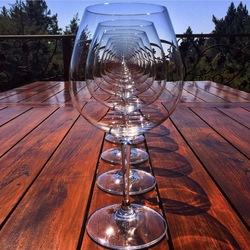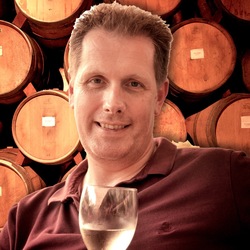Concrete
Château Brane-Cantenac
Grand Cru Classé en 1855 Margaux Red Bordeaux Blend 2005
I have a six-pack of this 05. I thought after 10 years in bottle, it would be interesting to check in on its evolution. While tasty, I’ll wait another 8-10 to open another. Even after 2-3 hours in the decanter, it’s still a very young adolescent. On the nose, slightly sour blackberries & dark cherries, dark currants, baked black plum, haunting blue fruits, anise, whiff of spice, steeped tea, dry stones, dry crushed rocks with dry top soil, caramel, vanilla with fresh & dry red florals. The body is thick & full. Tannins are starting to round out. It’s velvety on the palate. The fruits are; bright, fresh & ripe and really show the greatness of the 05 vintage. Dark currants, blackberries, dark cherries, baked black plum, haunting blue fruits, baked strawberries, cherries, raspberries on the long set, dark spice, clay & loamy dry top soil with crushed rocks, dry stones, cigar with ash, graphite, dry stems, slight herbaceous character, mint, used leather, clove, caramel, vanilla, fresh & dry red florals with violets. The round acidity is about perfect. The structure and length are still strong. The balance is in harmony. As for the long finish, it’s lush, ruby, rich and well polished. Photos of; Chateau Brane Cantenac, large wood vats, Henri Lurton and Estate vines. Producer notes and history...Chateau Brane Cantenac began in the early 17th century. At the time, the estate was known as Domaine Guilhem Hosten. Even that far back, wine was produced from the property. In fact, the wine was so highly regarded it was one of the more expensive wines in Bordeaux. It sold for almost as much money as Brane Mouton. This is interesting because of who went on to buy the vineyard in the 1800’s. The Baron of Brane, also known as “Napoleon of the Vineyards”, purchased the Chateau in 1833. At the time of the sale, the estate was called Chateau Gorce-Guy. To get the funds needed to purchase the Margaux vineyard, the Baron sold what is now called Mouton Rothschild, which was at the time of the sale, known as Chateau Brane-Mouton. Not such a good move with hundreds of years in hindsight! In 1838, the Baron renamed property taking his name and the name of the sector where the vineyards were located and called it Chateau Brane Cantenac. The Chateau later passed to the Roy family, who were well-known in the Margaux appellation in those days, as they owned Chateau d’issan. Moving ahead to 1920, the Societe des Grands Crus de France, a group of merchants and growers that owned several chateaux located in the Medoc including; Chateau Margaux, Chateau Giscours, and Chateau Lagrange in St. Julien, purchased Chateau Brane Cantenac. Five years later, M. Recapet and his son-in-law, François Lurton, took over Brane Cantenac along with Chateau Margaux. Lucien Lurton (the son of François Lurton) inherited Brane Cantenac in 1956. Today, the estate is still in the hands of the Lurton family. Brane Cantenac is owned and run by Henri Lurton. After being given the responsibility of managing Brane Cantenac, it was under the direction of Henri Lurton that large portions of the vineyard were replanted. Vine densities were increased, the drainage systems were improved and the plantings were also, slowly changed. The vineyard of Brane Cantenac is planted to 55% Cabernet Sauvignon, 40% Merlot, 4.5% Cabernet Franc and .5% Carmenere. Carmenere was used for the first time in the 2011 vintage. The only other Chateau I know that still uses Carmenere is Clerc Milon. The 75 hectare Left Bank vineyard of Brane Cantenac is essentially unchanged since it earned Second Growth status in the 1855 Classification. At least that is the case with the 45 hectares used to produce the Grand Vin of Brane Cantenac. Those 45 hectares are planted surrounding the Chateau. Those vines are located just in front of the Cantenac plateau and are the best terroir that Brane Cantenac owns. They have other parcels, which are further inland and much of those grapes are placed into their second wine, Le Baron de Brane. Those additional hectares can be divided into 3 main sections. Behind the Chateau, they have 15 hectares of vines on gravel and sand, 10 hectares across the road with sand, gravel and iron and a 13 hectare parcel with gravel called Notton, which is used for their second wine. The vineyard is planted to a vine density that ranges from 6,666 vines per hectare on the plateau and up to 8,000 vines per hectare for the vines located behind chateau, in their sandier soils. The higher levels of vine density are always found in the newer plantings. The terroir of Brane Cantenac consists of deep gravel, sand and clay soil. Experiments in the vineyards are currently looking at becoming more organic in their vineyard management. Today, more than 25% of Brane Cantenac is farmed using organic farming techniques. It is expected that over time, the amount of hectares farmed with organic methods will be increased. Brane Cantenac has gone through 2 relatively recent modernization’s in 1999, when they added began adding the first of their smaller vats to allow for parcel by parcel vinification and then again in 2015 when they completed a much more complete renovation of their cellars and vat rooms. While Brane Cantenac is a traditional producer, they are no stranger to technology as they were one of the first estates to embrace optical grape sorting machines. In very wet vintages, they can also use reverse osmosis. To produce the wine of Chateau Brane Cantenac, the wine is vinified in a combination of temperature controlled, traditional, 22 oak vats, 18 concrete tanks and 20 stainless steel vats that vary in size from 40 hectoliters all the way up to 200 hectoliters, which allows for parcel by parcel vinification. 40% of the fermentation takes place in the oak vats. The oldest vines are vinified in vats that are selected to allow for separate parcel by parcel vinification. The younger vines are vinified more often together in the same vats. However, the Carmenere is entirely micro-vinified, meaning that those grapes were completely vinified in barrel, using micro-vinification techniques. This can also happen because the amount of grapes produced is so small. Some vats can be co-inoculated, meaning they go through alcoholic fermentation and malolactic fermentation simultaneously. At Chateau Brane Cantenac, malolactic fermentation takes place in a combination of French oak tanks and barrels. The wine of Brane Cantenac is aged in an average of 60% new, French oak barrels for 18 months before bottling. The initial 2 months of aging is done with the wine on its lees, which adds more depth to the wine. There second wine is Le Baron de Brane. Le Baron de Brane is not new. In fact, previously, the second wine went under the name of Chateau Notton, which took its name from one of the main parcels where the grapes were planted. During the late 1950’s and into the 1960’s, having a second wine was important as the estate declassified 3 vintages, due to extremely poor, weather conditions in 1956, 1960 and 1963. Production of Chateau Brane Cantenac is about 11,000 cases per year. — 8 years ago

Pieropan
Soave Classico Garganega 2014
A lovely, spirited Soave Classico from the Pieropan, utterly fresh and bright with notes of Meyer lemon zest, white flowers, dried honey, and almond extract. Aged on fine lees in concrete, the effect of which is largely textural, lending minerally undertones of wet pomace, and slight autolytic character. A nice lingering finish. Clean and delicious, and I might add, great QPR. — 10 years ago
Domaine de Ferrand
Châteauneuf du Pape Red Rhone Blend 2011
Anyone who has rated this CDP below 9.0 has most likely made a mistake. That being that they opened it too young (I also did this rating the 2011 in 2015), but more importantly, did not give it adequate breathing time when they did so. Bravay keeps the co2 level very high during aging to prevent oxidation producing a wine that not only is going to age beautifully but NEEDS time to breathe. He also prefers tannin from skin not stems and oak so it is fermented and aged in stainless and concrete vats. After proper decanting, the 2011 leads with a full bouquet of dark berries, spice and a lovely violet note that keeps my nose in the glass. Medium to full in body with an elegant balance of ripe fruit and acid. Raspberry and juicy cherry fill my mouth with just a touch of pepper on the lingering finish. Tasted several times over 4 hours. Notes taken after 3 hours. — 10 years ago
Domaine Auguste Clape
Le Vin des Amis Syrah
This had this 12 years ago
Haywire
Haywire Vineyard Okanagan Valley VQA Pinot Noir 2014
First time I have had anything from Haywire. Small.production facility well hidden off the main hwy in Summerland. Interesting facility with the philosophy of letting the fermentation and the wine speaks for itself. No oak used in their cellars but concrete barrels and clay. Juicy, aromatic..unlike most pinots I have had. Worth a try and dog friendly🐶😄 — 7 years ago

Nicoletta de Fermo
Concrete Montepulciano d'Abruzzo
concrete forever. let's party — 8 years ago
Center of Effort
Giallo Solare
Edna Valley Chardonnay at its finest.
Balanced-Smooth-mellowed acidity but still very brightest. Naturally fermented and aged in concrete. Round-luscious-rich. I'm cooking up a whole branzino in my wood Fired oven. This will pair perfectly. — 8 years ago

Williams Selyem
Limestone Ridge at Vista Verde Vineyard Chenin Blanc 2014
Dry Chenin, tart, mineral, neutral, concrete edge, oily, spicy, quite nice — 9 years ago
Scribe
Skin Fermented Carneros Chardonnay 2014
Nice balance that is carried by a fuller texture from extended skin contact and concrete fermention #chardonnayallday — 9 years ago
Buty
Columbia Valley Sémillon-Sauvignon Blanc-Muscadelle Blend
The 14 is layered and awesome, and 60% concrete! — 10 years ago
Château Gilette
Crème de Tête Sauternes Sémillon-Sauvignon Blanc Blend 1990
Concrete. Buoyant with some pleasant oxidation — 10 years ago
Wind Gap Wines
Sceales Vineyard Old Vine Grenache 2013
The best of all 10 Wind Gap wines I tried today. And one of the cheapest. 13.75% alc and it shows. Love the Jolly Rancher strawberry flavor. Gum coating tannins. Wish more of their wines had this slight added layer of ripeness. From 85 year old vines grown on pure sand in Alexander Valley. Made in a concrete egg. A huge surprise. — 10 years ago
Andis Wines
Goedeck Liu Vineyard Meritage 2011
The 2011 Andis Meritage is a blend of 60% Merlot and 40% Cabernet Sauvignon. Aged in concrete tanks and finished with a nice compliment of French oak, the wine expresses aromas and flavors of cedar, strawberry, black cherry and coffee. Delicious paired with grilled meats, rich cheese and savory stews. #Andis #Meritage #ConcreteTanks — 11 years ago
Mer Soleil
Silver Unoaked Santa Lucia Highlands Monterey Co. Chardonnay 2012
Though it didn't have the usual buttery oakiness I've come to expect from Mer Soleil Chardonnay, I was thrilled to taste such rich fruitiness. Silver comes bottled in a "cement" bottle to remind us that it was aged in small concrete tanks from France. This allows, like oak, a trace of oxygen to seep in which helps to enhance the flavor. Very bright fresh fruit characters. It was opened at our home in Bensalem during a romantic Valentine's Day dinner with 2 other couples. — 12 years ago
Concrete
Lodi Cabernet Sauvignon 2014
Would drink again! — 8 years ago
Frog's Leap
Napa Valley Chardonnay
Light and refreshing on a hot summer day, drinks like a cool Riesling. Green apple and citrus. Aged in oak for 7 days then in concrete eggs to maintain its crisp flavor. — 8 years ago
Arkenstone
Estate Howell Mountain Sauvignon Blanc 2014
This Sauvignon Blanc spends a year in some new oak but mostly used oak and a 1/3 of it in concrete eggs. They also hold it back in bottle for another 1-1 1/2 years before they release it. On nose, great tropicals; melons, passionfruit, pineapple, banana peel, green apple, underripe Bosc pear with skin, citrus, citrus blossoms, jasmine and yellow florals. The mouthfeel is creamy & oily. It's very clean, pure, has precision and high mellow acidity. Green apple, green melon, citrus candy, peach, white peach, pineapple, guava, passion fruit, subtle light spice, delicate refined soft chalkiness with amazing body, texture and finish. Photos of their owner Ron leading the tasting. The concrete eggs used to ferment this Sauvignon Blanc. Their metal frog band adorning their grounds and those beautiful Howell Mountain vines sprung back to life. — 9 years ago
Azienda Agricola Montesecondo
Rosso Toscano Sangiovese Blend 2014
High elevation Sangiovese with whole cluster maceration. Aged in concrete and only 12.5 ABV — 10 years ago
Haywire
Canyonview Vineyard Chardonnay 2013
A very nice unique Chardonnay. This wine features herbs, pear, white peach with a balanced minerality. The concrete worked some magic. — 10 years ago

Thomas George Estates
Russian River Valley Concrete Chardonnay 2011
Buttery & Nice! — 11 years ago
Dirty & Rowdy
Skin and Concrete Egg Fermented Yountville Sémillon 2014
2014
I tried to keep my hands off... @Hardy Wallace Good thing I Have 7 more! — 11 years ago
Presqu'ile Winery
Santa Maria Valley Sauvignon Blanc 2012
A great Sauvignon Blanc from a boutique winery out of Santa Maria (Presqu'ile). Partly Presqu'ile and Riverbench vineyards this wine shows it's uniqueness with intriguing hints of jalapeño. Seven months in neutral oak, stainless steel and concrete egg. — 12 years ago
























Jordan Wardlaw
Medium ruby. More soil character than most of the other Borghetto wines in this range- mushroom and potting soil notes coming through. Wet concrete aroma and stronger sense of minerality as well. Again it’s a tart red fruit profile of pomegranate, peppermint candy, orange rind and menthol. Mid palate provides the necessary warm spice character and sweet tannins that turn much harder and more bitter on the finish. This will need more time to settle down and develop its fruit, but very complex and showing some great potential. — 7 years ago